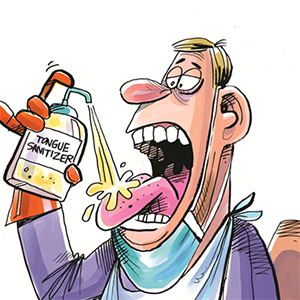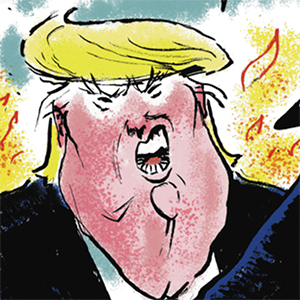Will we know the next president on election night? It's more likely than you might think
Published in News & Features
WASHINGTON — With polls showing a dead heat between Donald Trump and Kamala Harris entering Election Day, and local election officials cautioning it might take days to complete ballot counts, a conventional wisdom has taken hold: Americans are not likely to know their next president on Nov. 5.
Yet, the biggest surprise of all on election night might be if an apparent winner emerges sooner than expected.
Even if a handful of key states remain uncalled, one candidate may well surface with a clear path to victory if the rest of the electoral map is settled.
And a marginal polling error in the direction of either candidate could result in a clear and definitive Electoral College victory.
Major news organizations will not declare a winner until a candidate is confirmed to have secured 270 Electoral College votes. Laws in two elector-rich swing states — Pennsylvania and Wisconsin — do not allow their election officials to begin counting mail-in ballots until Election Day, making it highly unlikely their results will be confirmed that evening.
Arizona election officials also expect it will take several days to tabulate their results, with Maricopa County officials pointing to high interest across the state and an especially long, two-page ballot this election cycle.
But results in the remaining swing states — Michigan, North Carolina, Georgia and Nevada — could still paint an early picture of a likely winner.
Clear-cut Trump victories across these four states alone would be enough to secure him exactly 270 Electoral College votes that night, and victories in three of the four would require Harris to sweep all remaining battleground states in order to squeak out a victory.
On the other hand, victories for Harris in Michigan and Nevada – alongside a surprise win in North Carolina or Georgia, historically conservative states where Harris has consistently trailed in polling averages – would move Harris close to the presidency. She would need to win just one other battleground state to reach 270 and be declared the victor.
“Late-breaking results in American elections often break in the same direction,” said Andrew Rudalevige, a professor of government at Bowdoin College.
“If we saw Trump or Harris winning by much more than the polls had suggested — especially against the grain, however narrow that grain is — I suspect that is a harbinger of other results,” Rudalevige said. “That is, if Harris had a solid win in North Carolina or Trump in Michigan, that’s likely to be a good predictor that their turnout operations and persuasion of late-deciding voters has had an impact likely to be echoed in other close states.”
Four years ago, it took four days for the Associated Press to call the election for Joe Biden due to the COVID-19 pandemic that moved millions to vote early and by mail, altering the counting process in some battleground states.
With the COVID threat having significantly receded, it isn’t a virus that’s threatening a quick call this year, but the competitiveness of a stubbornly close race that polls show could come down to tenths of a percentage point across multiple states.
“In 2024 a lot will depend on the margins in the key states and Electoral College,” said Bruce Mehlman, a bipartisan consultant in Washington, who raised the prospect of another 2020 scenario when “George W. Bush’s minuscule 0.01% lead in Florida led to an epic recount, landmark Supreme Court case and 46 days of uncertainty.”
At the presidential level, a single-point deviation from the polling averages across swing states – in either candidate’s direction – could result in decisive victory.
Aggregates of national polls over the past month indicate that Trump and Harris are within a single percentage point of one another in the popular vote — and, more importantly, show similarly tight races across the seven battleground states that will decide the election, with Harris appearing to hold a slight lead in the Midwestern states and Trump maintaining a small lead in the Sunbelt states.
Pollsters say those leads are statistically insignificant and are all within the margin of error.
“It’s possible for either candidate to outperform their polling,” said Andrew Sinclair, director of the CMC-Rose Institute Poll at Claremont McKenna College, which just released a national poll Tuesday with YouGov that found Harris leading Trump. “We live in a time where there’s enough change in the technology that people are using, and the way that interacts with how people respond to surveys, that polling has gotten more interesting and more difficult. So it’s possible to miss either way.”
Georgia will be the first swing state to close its polls on election night, and a new law allows the state to count mail ballots two weeks before Election Day, said Elaine Kamarck, director of the Center for Effective Public Management at the Brookings Institution.
“Since they are already counting they should offer an early indication of where the race is going,” Kamarck said. “It looks like Trump has a slight edge there, so if Harris looks like she’s winning, it could be an indication of an upset.”
Polls will then close at 7:30 p.m. Eastern Time in North Carolina, which wasn’t called for Trump for 10 days in 2020. A new law there this year prohibits officials from beginning the count of early in-person ballots until after polls close.
“Typically, by midnight we get a 99% report rate from across the state,” Michael Bitzer, the chair of the politics department at Catawba College wrote in an email. “But if any of the state-wide races are razor thin, we’ll have to see how things play out.”
The “blue wall” states of the Midwest will come next. Michigan’s Democratic secretary of state, Jocelyn Benson, has said that state election officials expect to have verifiable results “within 24 hours” of polls closing across the state.
“In 2020, we had the results of our highest-turnout election in Michigan history within 24 hours of the polls closing,” Benson told CBS last week. “The unofficial results were completed by 8 p.m. on Wednesday, so we’re tracking that again this year.”
While most local clerks in Michigan may start counting absentee ballots eight days before Election Day, they aren’t required to. One city clerk in Warren, which sits inside the battleground county of McComb, has already said she’s choosing to wait to begin processing ballots.
“Warren isn’t going to start counting its absentee ballots until Election Day, which of course is going to delay things in that city and in that county. That could be the votes that one side needs to carry the state,” noted Dave Dulio, a professor of political science at Oakland University.
But because of laws regarding mail-in ballots in the other blue-wall states of Pennsylvania and Wisconsin, “these critical states are a mixed bag,” Kamarck said. “We’ll probably know Michigan pretty early, Wisconsin next and Pennsylvania perhaps not until the next day.”
Robert Graci, a former Pennsylvania judge and a member of the election integrity group “Keep Our Republic,” predicted Pennsylvania results would be available quicker than 2020.
“I don’t think this time around we’re going to be waiting until Saturday to get the results from Pennsylvania. I think they should be done earlier,” Graci said. “Do I expect to see the same types of (legal) challenges? Yes, unfortunately.”
Finally, the Western swing states of Arizona and Nevada will begin reporting results, with Nevada polls closing at 7 p.m. Pacific Time. Nevada is expected to report all of its results on election night.
If the polls are consistently underestimating either candidate by three or four points — as they have in the past three presidential cycles, in 2012 underestimating Democrats and in 2016 and 2020 underestimating Republicans — then results could show a clear winner relatively early on election night, Sinclair said.
“If it looks like, here we go again — Trump’s running really far ahead in the returns in the Midwest, and we were off by 5 percentage points on Harris, and it’s a slaughter — you could know on election night,” Sinclair said.
Public perception of a delayed result, with days passing without a declared winner, contributed to false Republican narratives pushed by Trump that fraud tainted the 2020 presidential election – a conspiracy theory that fueled a mob of Trump supporters to attack the U.S. Capitol on Jan. 6, 2021, said Peter Kastor, chair of the History Department at Washington University in St. Louis.
“In 2020, the tight margin of victory for Joe Biden provided the excuse for the Trump campaign to deny defeat and, in the end, helped light the fire on January 6. Now Americans will likely face the same thing all over again, no matter who eventually wins,” Kastor said.
The delays constitute a substantial break in modern U.S. history of knowing presidential election results within a day of the vote.
“By the time Abraham Lincoln was elected in 1860, newspapers carried news of the victorious campaign the day after the election,” Kastor added. “A quick and clear outcome was a symbol of a system that worked.”
_________
©2024 McClatchy Washington Bureau. Visit at mcclatchydc.com. Distributed by Tribune Content Agency, LLC.







Comments